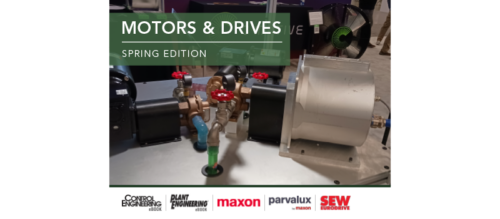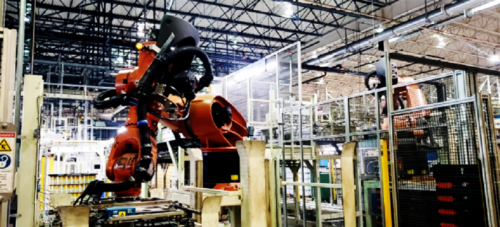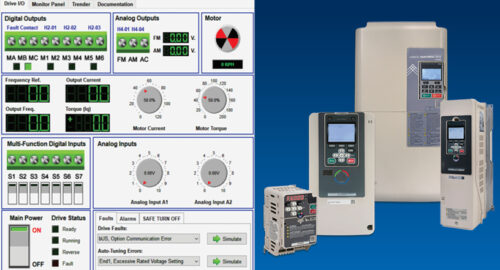Integrated motors offer flexibility with fewer components
Integrated motors save space compared to separate motor and drive components by reducing the number of components in the system, simplifying cabling and reducing costs over conventional solutions.
Many industrial applications rely on a servo or step motor-based motion controller for their manufacturing, production or robotic systems. These traditionally consist of a motor, drive and the necessary cables to connect them. To meet the continuous demand to reduce the size of automation systems, machine builders often spend considerable time mounting motors and drives and routing cables in configurations to reduce space.
Integrated motors save space compared to separate motor and drive components by combining the servo or step motor with onboard drives and controllers. Integrated motors are designed to reduce the number of components in the system, simplifies cabling, and reduces costs over conventional designs. By switching to integrated motors, machine builders can free up valuable space to better accommodate other critical components such as sensors, material handling mechanisms and operator interfaces (OIs) while reducing the overall machine footprint. Figure 1 depicts how integrated motors can offer a cleaner design for motion control applications.
Integrated motor configurations
Integrated step motors (see Figure 2) house the drive electronics at the back of the motor, near the feedback device and/or along one side of the motor. Electrical connections for power, communications, and input/outputs (I/Os) also are positioned near the back or side of the motor, usually grouped together on one surface. No other external electronics package is required to drive or control the motor.
Figure 3: Exploded view of an integrated servo motor where the servo drive/controller is mounted at the back of the motor, eliminating the need for an external servo drive and cables to connect the drive and motor together. Courtesy: Applied Motion[/caption]
Four integrated motor benefits
Integrated motors offer several important benefits:
- Fewer components and simplified wiring: With the drive and control electronics housed in the same enclosure as the motor, integrated motors do not require additional external electronics for control. Connectors for power, communications, and I/O are easily accessible. Machine builders can wire command signals from a central processing unit (CPU) to the integrated motor. Many integrated motors include onboard support for industrial networking protocols including EtherNet/IP, Modbus and CANopen as well as control modes such as discrete I/O interfaces.
- Smaller control panels: By eliminating the separate drive components, the size and number of control panels that house them are greatly reduced. In some cases, control panels are eliminated from a system.
- Simplified product selection: Integrating the motor and drive into one unit helps eliminate questions about drive/motor compatibility, cable length and other system selection issues.
- Cost savings: Reducing the number of components in the system saves money in the bill of materials (BOM) and time due to simplified component selection and installation.
Fewer components, simpler wiring
An example of a 4-axis motion control system using separate motors and drives will demonstrate the reduction in components, wiring complexity, and control panels achieved when switching to integrated motors.
Figure 4 shows a typical 4-axis motion control design using separate motor and drive components. The four servo drives mounted inside the control panel, along with the dc power supply and programmable logic controller (PLC), must be connected to the four servomotors mounted around the machine. Home switches/sensors on each axis require additional cables to connect back to the servo drives, resulting in 12 cables routed from the control panel to the machine.
Smaller control panels
Figure 5 shows the same 4-axis motion control solution where integrated motors replace separate servomotor and drive components. Only the dc power supply and PLC are mounted inside the control panel, which reduces its size. No motor power or feedback cables are needed between the control panel and axes. Home switches/sensors are connected to the integrated motors, reducing the number of cables back to the control panel.
The only cables running from the control panel to the axes are dc power and one network connection cable; dual-port communications connections on the integrated motors allow daisy-chain connections in the network. Cables between the control panel and the axes are reduced to five.
In addition, the control panel gets 50% smaller by eliminating separate servo drives.
Simplified product selection
Integrated motors also simplify product sizing and selection. When choosing separate motor and drive components, users face questions like:
- What drive works best with this motor?
- What cables must be used to connect the motor and drive?
- Does the drive support my encoder type?
Integrated motors eliminate these and other similar questions because the drive is already optimally sized and configured for the motor, and no cables are needed between the drive and motor. While these are seemingly minor details, they have a practical impact on users and reduce the product selection process.
Cost savings
In most cases, an integrated motors and drives are less expensive than using separate motors and drives. See comparisons below for NEMA 24 stepper motors and 200W servomotors. The integrated motor provides cost savings in both cases.
| Conventional Motor with Separate Drive and Cable | Integrated Motor |
| 200W Servo Motor: $425
Servo drive with CANopen: $436 Motor power cable: $12 Motor feedback cable: $72 TOTAL: $945
|
200W Integrated Servo Motor w/CANopen: $772
TOTAL: $772
18% Savings |
| NEMA 24 Step Motor: $172
Stepper drive w/CANopen: $649 TOTAL: $821 |
NEMA 24 Integrated Stepper w/CANopen: $706
TOTAL: $706 14% Savings |
Integrated motor performance
When using an integrated motor, torque and speed remain essentially the same as separate motor and drive components. Figure 6 compares torque-speed curves for integrated and non-integrated motors and drives. In most applications, any differences are negligible.
Integrated motor limits
While the benefits of integrated motors are real, they are not best for every application. Currently available integrated motors capable of running on off-the-shelf industrial power supplies top out at about 600W continuous power in the case of servos and up to a NEMA 34 frame in steppers.
Integrated motors that provide more than 600W continuously (up to 6kW) require either ac voltages supplied directly to the integrated motor or dc power supply systems that create very high dc bus voltages in a safe way.
The addition of conversion components in an integrated motor makes the overall size of the package much larger, which decreases space-saving benefits. Sophisticated, high-voltage dc power supply systems add cost and negate much of the simplicity in product selection. For these reasons, machine builders benefit most using integrated motors in the sub-600W range, where the market offering is the broadest and off-the-shelf industrial power supplies, usually providing 48Vdc, are most commonly used to power the integrated motors. For applications requiring more than 600W of continuous power, using separate motor and drive components remains the best choice in most situations.
When choosing an integrated motor, weigh the benefits against the limitations. Saving space, convenience in product selection and application, fewer components, simplified cabling, and reduced costs are good incentives to consider when replacing standard motors with integrated motors.
Eric Rice is national marketing director, Applied Motion Products. Edited by Chris Vavra, production editor, Control Engineering, CFE Media, cvavra@cfemedia.com.
MORE ANSWERS
Keywords: integrated motors, motors and drives
Integrated motors can reduce costs and save space for manufacturers.
With the added space, machine builders can add critical components while reducing the overall machine footprint.
When using an integrated motor, torque and speed are the same as separate motor and drive components.
Consider this
What is your biggest consideration when deciding whether to use an integrated motor or not?
Original content can be found at Control Engineering.
Do you have experience and expertise with the topics mentioned in this content? You should consider contributing to our CFE Media editorial team and getting the recognition you and your company deserve. Click here to start this process.






